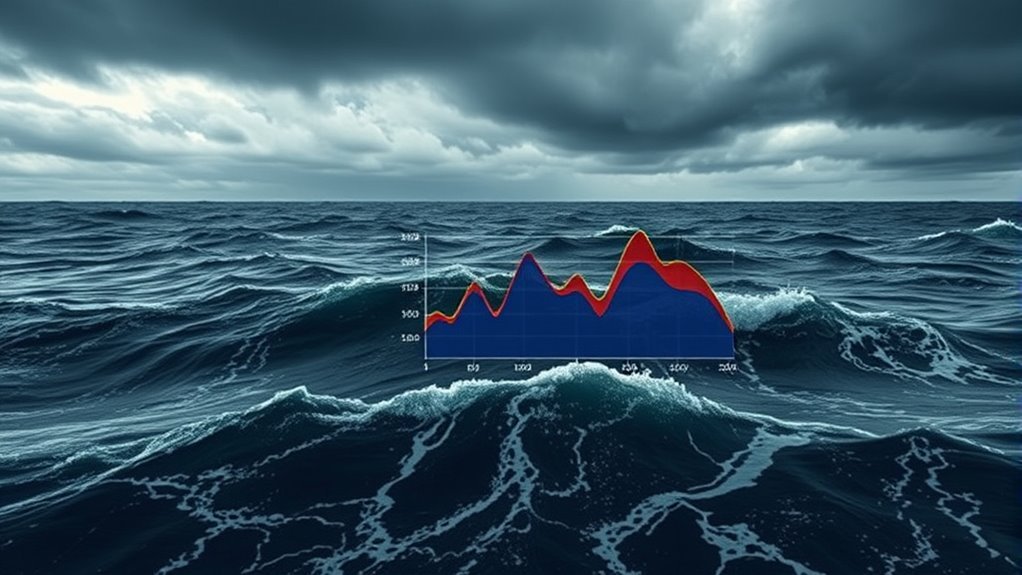Scientists study squalls using advanced meteorological models that analyze atmospheric data and patterns. They utilize high-resolution radar technology for real-time tracking of squall formations. Field research and storm chasing provide firsthand data, augmenting understanding of squall dynamics. Historical data analysis helps identify patterns in past squalls, improving predictive accuracy. Collaborations between researchers and meteorological organizations further boost forecasting capabilities. There's more to uncover about the techniques and innovations in squall research.
Main Points
- Scientists utilize advanced meteorological models that analyze atmospheric data to enhance squall forecasting accuracy.
- Field research and storm chasing provide firsthand observations, enriching the understanding of squall dynamics and characteristics.
- Historical data analysis, including satellite imagery and radar observations, improves insights into past squall events, aiding future predictions.
- Collaborative partnerships facilitate data sharing and joint research initiatives, leading to advancements in squall prediction methodologies.
- Machine learning algorithms and high-resolution imaging enhance pattern recognition and real-time monitoring of squall developments.
Understanding Squalls: Definition and Characteristics
Squalls are intense, brief bursts of wind often accompanied by rain, hail, or snow. These phenomena typically occur during the passage of a cold front, leading to sudden changes in weather conditions. Characteristically, squalls can produce strong gusts that may exceed 30 knots, creating hazardous conditions for aviation and maritime activities. The rapid onset of these winds can last from a few minutes to several hours, often resulting in a stark contrast to the preceding calm weather.
Squalls are most commonly observed in regions with dynamic atmospheric systems, such as coastal areas and mountainous terrains. The presence of atmospheric instability and moisture contributes to their formation, allowing for the development of convective clouds.
Additionally, squalls can vary in intensity and duration, making them challenging to predict. Understanding these characteristics is essential for scientists as they study squalls and their impact on local weather patterns, ultimately enhancing public safety and preparedness.
The Role of Meteorological Models in Squall Prediction

While unpredictable in nature, squalls can be more effectively anticipated through the use of advanced meteorological models. These models integrate various atmospheric data, including temperature, humidity, and wind patterns, to simulate and predict squall formation and movement.
By employing high-resolution grid systems, meteorologists can analyze localized weather phenomena that contribute to squall development. The models utilize complex algorithms that account for the dynamic interactions within the atmosphere. This allows scientists to forecast potential squall occurrences with greater accuracy and timeliness.
Additionally, statistical techniques improve model reliability by comparing predicted outcomes with historical data. As these models evolve, they incorporate real-time data from various sources, enhancing their responsiveness to changing weather conditions.
Consequently, meteorological models play a vital role in informing both weather agencies and the public, ultimately boosting preparedness for the sudden impacts of squalls.
Advanced Radar Technology and Its Impact on Squall Tracking
Advanced radar technology has revolutionized squall tracking by providing improved resolution imaging that captures fine atmospheric details.
This capability, combined with real-time data analysis, allows meteorologists to monitor squall developments as they happen.
Moreover, these advancements assist predictive modeling techniques that improve the accuracy of squall forecasts.
Enhanced Resolution Imaging
As scientists seek to improve their understanding of atmospheric phenomena, upgraded resolution imaging has emerged as a vital tool for tracking squalls. This advanced radar technology improves the ability to capture detailed images of storm structures, allowing for better identification of squall lines and their dynamic behaviors.
Improved resolution imaging provides meteorologists with more accurate data on wind patterns, precipitation rates, and storm movement. This precision enables timely forecasts and improved warnings, ultimately aiding in disaster preparedness.
The technology uses sophisticated algorithms to analyze atmospheric conditions in real-time, offering perspectives that were previously unattainable with lower-resolution systems. Consequently, it plays an important role in advancing squall tracking and contributes to the comprehensive improvement of weather prediction capabilities.
Real-Time Data Analysis
Harnessing the power of real-time data analysis, meteorologists are now able to interpret and respond to squall developments with unparalleled speed and accuracy.
Advanced radar technology, such as Doppler radar, provides critical information on wind patterns, precipitation intensity, and storm structure, allowing for immediate assessments of squall conditions. This capability enables forecasters to monitor rapidly changing weather systems and issue timely warnings.
The integration of data from multiple radar sources improves situational awareness and promotes collaboration among meteorological agencies. Additionally, real-time data analysis streamlines the identification of potential squall formation areas, improving tracking and response efforts.
Predictive Modeling Techniques
Numerous predictive modeling techniques have emerged from advancements in radar technology, markedly improving squall tracking capabilities. High-resolution radar systems now provide detailed information about precipitation patterns and wind velocities, allowing meteorologists to develop more accurate models.
These models utilize algorithms that assimilate real-time data, enhancing forecasts by integrating various atmospheric parameters. Machine learning techniques further refine predictions by analyzing historical squall data and identifying patterns that traditional methods might overlook.
Additionally, ensemble forecasting, which combines multiple model outputs, increases reliability by capturing the uncertainty intrinsic to weather systems. As a result, these improved predictive modeling techniques enable scientists to issue timely warnings and better inform the public about potential squall impacts, ultimately contributing to enhanced safety and preparedness.
The Importance of Field Research and Storm Chasing

Field research and storm chasing play a critical role in advancing the understanding of squalls, providing scientists with essential firsthand data. These activities enable researchers to observe squalls in real-time, capturing data on wind speed, temperature fluctuations, and precipitation patterns. This direct observation is priceless, as it allows scientists to validate theoretical models and improve predictive accuracy.
Storm chasers often deploy sophisticated equipment to gather meteorological data, such as Doppler radar and weather balloons, which enrich the understanding of squall dynamics. By documenting the formation and evolution of squalls, field researchers can identify key features that contribute to their intensity and longevity.
Furthermore, the knowledge gained from these experiences contributes to better forecasting techniques, eventually improving public safety during severe weather events. The combination of field research and storm chasing is therefore essential for developing a thorough understanding of squalls and their impact on weather systems.
Analyzing Historical Data to Identify Patterns in Squalls

Scientists utilize various data collection techniques to gather historical information on squalls.
By identifying key variables such as temperature, humidity, and wind patterns, researchers can begin to acknowledge patterns that may predict future occurrences.
This analytical approach improves understanding of squall dynamics and informs forecasting models.
Data Collection Techniques
Historical data serves as an essential resource for understanding squalls, enabling researchers to uncover patterns and trends associated with these sudden weather events.
Various data collection techniques are employed to gather relevant information, including satellite imagery, radar observations, and ground-based measurements. Satellite data provides a broad view of atmospheric conditions, while radar systems offer real-time tracking of precipitation and wind patterns. Ground-based stations contribute localized data, enhancing the comprehensive understanding of squall dynamics.
Researchers also utilize data from buoys and ships to monitor oceanic influences on squalls. By aggregating these diverse data sources, scientists can analyze past occurrences and refine their models, finally improving predictive capabilities for future squall events and their potential impacts on weather systems.
Identifying Key Variables
Analyzing data from diverse sources allows researchers to identify key variables that influence squalls. By examining historical weather records, satellite imagery, and radar data, scientists can pinpoint factors such as temperature fluctuations, humidity levels, and wind patterns.
These variables play a critical role in the formation and intensity of squalls. Researchers also consider geographical features, such as proximity to bodies of water and topography, to understand how these elements interact with atmospheric conditions.
This systematic analysis aids in developing a thorough understanding of squall dynamics. In the end, recognizing these key variables is essential for improving predictive models and enhancing the accuracy of weather forecasts related to squall events, thereby informing both public safety and preparedness initiatives.
Pattern Recognition Methods
Pattern recognition methods play a vital role in understanding squall phenomena by uncovering trends and correlations within historical weather data.
These techniques enable scientists to analyze extensive datasets, identifying important patterns that contribute to the formation and intensity of squalls. By employing various algorithms and statistical tools, researchers can improve predictive accuracy and enhance preparedness.
Key aspects of these methods include:
- Data Mining: Extracting useful observations from large datasets.
- Time-Series Analysis: Evaluating how squall characteristics evolve over time.
- Machine Learning: Utilizing algorithms to predict future squall events based on past occurrences.
- Spatial Analysis: Understanding the geographical distribution of squalls and related meteorological factors.
Through these approaches, scientists aim to refine weather predictions and mitigate the impacts of squalls.
Collaborations Between Scientists and Meteorological Organizations
As squalls can develop rapidly and unpredictably, collaborations between scientists and meteorological organizations are essential for enhancing forecasting accuracy and understanding these weather phenomena. These partnerships promote the sharing of data, resources, and knowledge, enabling a more thorough analysis of squall behavior.
For instance, meteorological organizations often provide real-time radar and satellite observations that scientists can analyze to identify patterns and triggers associated with squalls.
Additionally, joint research initiatives allow for the development of advanced modeling techniques that incorporate both observational data and theoretical frameworks. By working together, scientists and meteorological organizations can conduct field studies, enhancing the understanding of squall dynamics in various geographical contexts.
Such collaborations also contribute to improved public safety by ensuring that timely and accurate weather warnings can be issued, eventually benefiting communities at risk from these sudden storms. Through these synergistic efforts, the scientific community continues to refine predictive capabilities for squalls.
The Future of Squall Research and Weather Prediction Techniques
While advances in technology continue to reshape meteorology, the future of squall research and weather prediction techniques holds the promise of even greater accuracy and efficiency. Researchers are optimistic about integrating cutting-edge tools and methodologies that will improve predictive capabilities.
Key developments in squall research include:
- High-Resolution Satellite Imagery: Improved satellite technology will provide real-time data, enabling better monitoring of squall formations.
- Machine Learning Algorithms: These algorithms can analyze extensive datasets to identify patterns and predict squall occurrences more effectively.
- Advanced Numerical Weather Models: Enhanced computational power will allow for more sophisticated simulations of atmospheric conditions, improving forecast reliability.
- Collaborative Data Sharing Platforms: Increased collaboration among institutions will promote access to diverse datasets, leading to more thorough analyses of squall phenomena.
As these advancements unfold, they are expected to revolutionize how meteorologists approach squall prediction, eventually benefiting public safety and preparedness.
Common Questions
How Do Squalls Differ From Other Weather Phenomena?
Squalls are sudden, intense bursts of wind and rain, differing from other weather phenomena by their short duration and localized impact. They often occur rapidly, contrasting with longer-lasting systems like storms or hurricanes.
What Safety Measures Should Be Taken During a Squall?
During a squall, individuals should seek shelter indoors, avoid raised areas, secure loose objects, and stay informed through weather alerts. Remaining calm and prepared improves safety during these intense and often sudden weather events.
Can Squalls Occur in Every Season?
Squalls can occur in every season, although their frequency and intensity may vary. Typically, they are more common during spring and summer, but winter squalls can also develop, particularly in regions with considerable temperature contrasts.
How Does Climate Change Affect Squall Frequency?
Climate change influences squall frequency by altering atmospheric conditions, potentially increasing the intensity and occurrence of these weather events. Warmer temperatures can lead to more moisture in the air, enhancing the likelihood of squalls forming.
Are Squalls More Common in Certain Geographical Areas?
Squalls tend to be more prevalent in coastal and tropical regions, where warm, moist air interacts with cooler air. These geographical areas experience conditions conducive to the development of intense, short-lived storms known as squalls.

